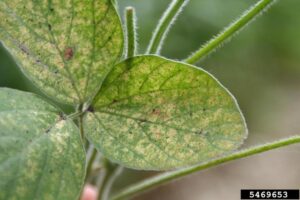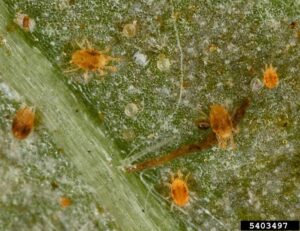Since it’s been dry, there has been a lot of talk about spider mites. So far, to my knowledge, no spider mites have been “spotted”. Perhaps, it has not been hot enough (yet) for the two-spotted spider mite. As we move forward, we should be prepared. Two-spotted spider mites are very small (less than .002 inch) and can be green, yellow, or orange with 2 dark spots on their abdomen. Remember that they are spiders, or arachnids, and have 8 legs.
Hosts and Reproduction
They will attack a wide variety of plants and colonize the underside of the leaves with webs. Depending on the temperature, spider mites will go through their lifecycle in 5 to 19 days. Hotter days (> 90 F) will accelerate their reproduction. Unfortunately, since females can produce up to 100 eggs, their populations can explode.
Natural Enemies
Normally, spider mite populations are kept in check by natural enemies, weather, and host quality. But, during a drought, spider mite movement to soybeans can occur and outbreaks can occur in hot weather when spider mite reproduction speeds up and predators can no longer control them. In some cases, an application of an insecticide will kill beneficial insects or cause spider mites to have more offspring (hormolygosis).
Recently, Dr. Nick Seiter, University of Illinois entomologist, reported on this topic in his latest crop report. He said, “If the drought continues, these (spider mites) become increasingly likely in soybean. This is a great reason to hold off on broad spectrum insecticide applications, which don’t touch the mites but eliminate their natural enemies. This is also a good reason not to mow your grass ways if you don’t have to.”
Damage
Spider mites use their piercing mouthparts to suck out cell contents. The result is white or yellow spots on leaves or “stippling” on the underside of leaves. As spider mite populations grow and injury increases, leaves go from grayish to yellow, brown, or coppery, and then drop off from the plant. Injury will start on the lower canopy and work their way up the canopy.
Scout
As soybean approach beginning pod (R3), check stressed soybeans on field edges or within the field. If you don’t have a hand lens to look for spider mites, the trick is to shake infested leaves on a piece of white paper. If you find spider mites on field edges, you will need to check several areas of the entire field.
Miticide
Spider mite damage is not reversable, so we need to focus on protecting the middle and upper soybean canopy. If you start finding heavy stippling on lower leaves (with leaf yellowing and leaf drop) that progresses into the middle canopy with some mite colonies starting on the upper canopy, it may be time to spray a miticide.
It is very important that you spray a miticide or insecticide that has mite activity as some insecticides may cause spider mite populations to increase. Good coverage of the miticide is key since mites are on the underside of the leaves. Remember to re-scout the field after 5 days of a miticide application and continue to scout until the R6 growth stage. Don’t respray with the same miticide but use different modes of action to deter miticide resistance.
Yield Loss
If spider mites are left untreated, especially at the pod (R4) and beginning seed (R5) stage, they can reduce photosynthesis and increase drought stress, which can lead to fewer pods, less seeds, and smaller seeds size.
Reference: Managing spider mite on soybean (umn.edu)

Credit – Daren Mueller, Iowa State University, Bugwood.org

Credit – David Cappaert, Bugwood.org.


 and then
and then